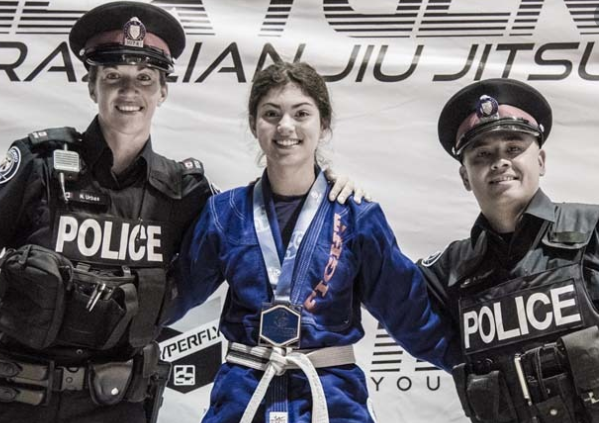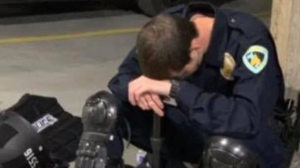I watched a video the other day of two police officers attempting to arrest an individual for who knows what. Doesn’t matter. What does matter is that it appeared they were absolutely avoiding grabbing the subject around the head and tackling him to the ground. I didn’t interview the officers and I am not a tactics expert, but that’s what it looked like. So, let’s just assume that it’s true since there is no harm in that for the purpose of this post.
A few weeks ago I asked my son TJ, an active rookie cop in our nation’s capital, his thoughts on what’s coming down on use of force and anything coming out of the DC Council’s Emergency Police Reform bill. One of the many changes is the banning of the “choke-hold”. We all know Daniel Pantaleo, formerly of the NYPD, did not intentionally use a “choke-hold” but was fired for using a “choke-hold”. In my opinion after viewing the video tape many times, it appears to me that Pantaleo grabbed the subject Eric Garner, who was in excess of 300 lbs. and resisting arrest, in a head lock and his forearm ended up in a position for a period of time against Garner’s throat – an act the Medical Examiner, Dr. Floriana Persechino, is calling a “chokehold”. According to Persechinio, Garner died as a result of the co-morbidities (asthma, high blood pressure, obesity) in conjunction with the application of the “choke-hold”. NBC News quoted NYPD Police Commissioner James O’Neil on the day he fired Pantaleo: “Had I been in Officer Pantaleo’s situation I may have made similar mistakes,” O’Neill said. “I would have wished I had released my grip before it became a choke-hold.” This could happen to any cop any day any time. TJ responded simply about all the reforms as, “not good”. But I brought him back to the choke-hold ban and asked him if I could send him to a jujitsu school on my dime. He was open. He will be going – there are some things a father can still order his adult son to do. Then today, in talking to an old and respected colleague, my friend stated that in his opinion, every cop owes it to themselves and each other to get in the best shape of their life and to learn grappling, take-down and submission techniques.
So, in the spirit of never wanting to see another police officer ever hurt again, where they may have held back from using any and every strategy to protect themselves and in order to never “intentionally” hurt a subject that resists arrest I am calling on every police officer to do two things: 1. Get into the best shape of your life, and 2. Become a master at a martial art. And trust me, coming from someone on the NYPD for over 20 years who was neither of those things I do realize I did not take my own advice. I know the hypocrisy claims will fly. But we are in a different world. So, lets just say I have evolved. Better yet, instead of the onus being on the cop themselves, how about in-service training of 30 min of strength and conditioning and 30 min of defensive tactics every day built into their tours. The California Commission on Peace Officer Standards and Training (POST) requires that officers get eight hours of defensive tactics training every two years. That’s right, four hours a year. NOT GOOD ENOUGH! Officers should remember though, to use the newly acquired “tools” within departmental policy and guidelines!
In researching the “arts”, it appears Jujitsu is probably the best route to go. I found this excerpt on the website: berkeleywellness.com in an article written by Janine Barone on The Art and Science of Martial Arts.
Jujitsu. Developed in China and Japan, this martial art is a forerunner of both aikido and judo. All three martial arts rely on grappling, a technique that involves fighting in close proximity to your opponent with lots of body contact; it can involve anything from throws to strangle-type holds to taking your opponent to the ground or floor and fighting there. Jujitsu uses the attacker’s momentum to do joint locks (in which you force your opponent’s joint, such as an elbow or knee, beyond its normal range of motion, resulting in pain or injury) to restrain the opponent. One variant, Brazilian jujitsu, relies on choking the opponent and continuing the fighting on the ground.
Aikido. Like jujitsu, this Japanese martial art—meaning “the way for harmony” or “unification of your spiritual energy” or ki—makes use of the momentum and strength of the opponent to achieve your objective (sometimes called “nonresistance”). Aikido doesn’t use kicking and makes less use of hand strikes than jujitsu. Instead, the practitioner uses a lot of turning motions and pushing movements accompanied by joint locks.
Judo. This martial art also originated in Japan. Like jujitsu and aikido, it’s based largely on grappling, but in this case with an emphasis on throws and pinning the opponent to the ground.
I also found these websites/articles: Gracie University Brazilian Jujitsu and Breaking Muscle
Be Safe. Get in Shape. Stay Vigilant! Let comments fly!





